#renewable electricity
Note
hey, how do you cope with people saying we only have a small amount of time left to stop the worst effects of climate change? no matter how hopeful and ok i am, that always sends me back into a spiral :(
A few different ways
1. The biggest one is that I do math. Because renewable energy is growing exponentially
Up until basically 2021 to now, all of the climate change models were based on the idea that our ability to handle climate change will grow linearly. But that's wrong: it's growing exponentially, most of all in the green energy sector. And we're finally starting to see proof of this - and that it's going to keep going.
And many types of climate change mitigation serve as multipliers for other types. Like building a big combo in a video game.
Change has been rapidly accelerating and I genuinely believe that it's going to happen much faster than anyone is currently predicting
2. A lot of the most exciting and groundbreaking things happening around climate change are happening in developing nations, so they're not on most people's radars.
But they will expand, as developing nations are widely undergoing a massive boom in infrastructure, development, and quality of life - and as they collaborate and communicate with each other in doing so
3. Every country, state, city, province, town, nonprofit, community, and movement is basically its own test case
We're going to figure out the best ways to handle things in a remarkably quick amount of time, because everyone is trying out solutions at once. Instead of doing 100 different studies on solutions in order, we get try out 100 (more like 10,000) different versions of different solutions simultaneously, and then figure out which ones worked best and why. The spread of solutions becomes infinitely faster, especially as more and more of the world gets access to the internet and other key infrastructure
4. There's a very real chance that many of the impacts of climate change will be reversible
Yeah, you read that right.
Will it take a while? Yes. But we're mostly talking a few decades to a few centuries, which is NOTHING in geological history terms.
We have more proof than ever of just how resilient nature is. Major rivers are being restored from dried up or dead to thriving ecosystems in under a decade. Life bounces back so fast when we let it.
I know there's a lot of skepticism about carbon capture and carbon removal. That's reasonable, some of those projects are definitely bs (mostly the ones run by gas companies, involving carbon credits, and/or trying to pump CO2 thousands of feet underground)
But there's very real potential for carbon removal through restoring ecosystems and regenerative agriculture
The research into carbon removal has also just exploded in the past three years, so there are almost certainly more and better technologies to come
There's also some promising developments in industrial carbon removal, especially this process of harvesting atmospheric CO2 and other air pollution to make baking soda and other industrially useful chemicals
As we take carbon out of the air in larger amounts, less heat will be trapped in the atmosphere
If less heat is trapped in the atmosphere, then the planet will start to cool down
If the planet starts to cool down, a lot of things will stabilize again. And they'll probably start to stabilize pretty quickly
#Anonymous#ask#me#carbon removal#carbon sequestration#carbon emissions#air pollution#forests#afforestation#wetlands#regenerative farming#regenerative agriculture#agriculture#renewable energy#renewable electricity#solar power#wind power#climate change#climate anxiety#climate resilience#good news#hope#hope posting
5K notes
·
View notes
Video
Those emissions are also our emissions
#tiktok#climate change#climate action#climate-change#climate crisis#renewable electricity#renewable energy#green technology
3K notes
·
View notes
Text
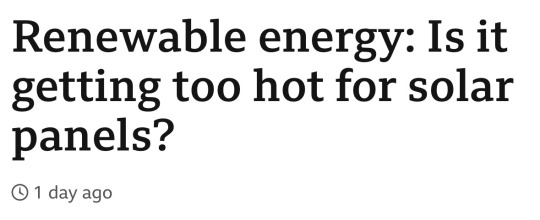

Source
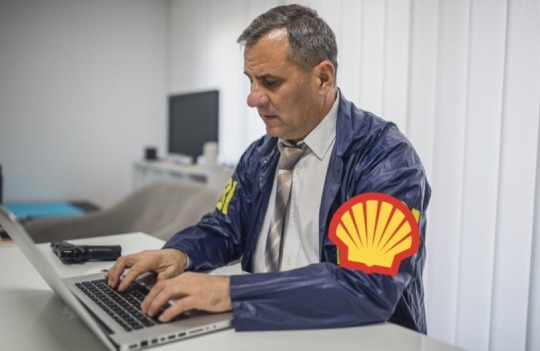
#capitalism#government#solar energy#solar panels#solar power#renewable electricity#climate change#news#current events#the left#ban fossil fuels#green energy#green new deal
913 notes
·
View notes
Photo
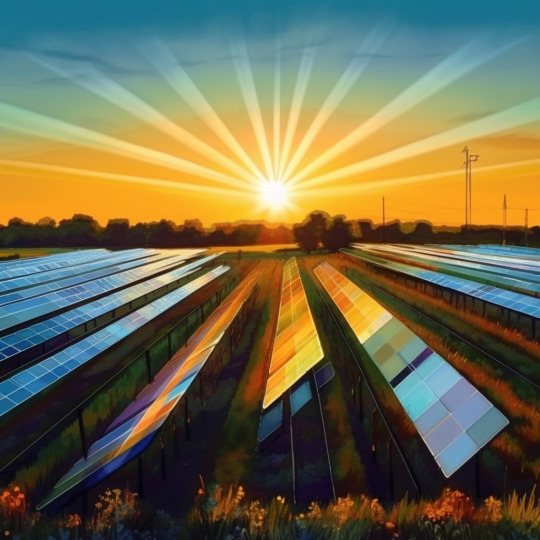


Envision Our Energizing-Vibrant Renewable Future Now
#earth day#earth month#renewable energy#renewable power#ai art#ai#image generation#design#climate art#renewable electricity#power sources#vibrant skies#solar power#solar#wind#wind energy#green future#solarpunk#renewables#midjourney#imagination#image building
242 notes
·
View notes
Photo
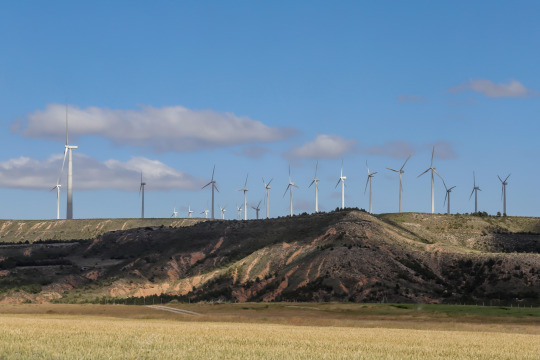
Navarra landscape by sir20
#photographers on tumblr#original photographers#photography#landscape#fine art photography#sir20#wind#windmill#wind turbines#mountains#navarra#españa#spain#europe#landscapes#landscape photography#renewable sector#renewable energy#renewable electricity#renewable#sky#clouds#original photography#artists on tumblr#creators on tumblr#Photographie#fotografia#fotografie#fotografía#foto
179 notes
·
View notes
Text

#renewable electricity#renewable energy#windmill#wind park#wind power#fire#turbines#accident#renewable power generation#Gif#wind solar#electricity
87 notes
·
View notes
Text
some good news for a change...
This is... kind of a big deal? I think?
'
Orange County, California, has set up a CCE, a local nonprofit Community Choice Energy program. CCEs allow cities to purchase power, usually renewable, independently of for-profit power companies, with a view to competition and choice in how much renewable energy customers can opt into.
California's grid has a ton of renewable energy— in fact it recently hit 100% of demand in the spring with just renewables— and is expanding capacity rapidly. So there's quite a few regional CCEs in the state already.
OC is a big one. With the wealthy city of Irvine paying up front costs, as it did for a recycled water system when it was first built in the 60s that neighboring cities have gradually plugged into, it's starting with a little under a million customers starting at 70-100% renewables, depending on each city's contract. More cities should join, once they see results.
This means homeowners (and, especially, renters and apartment/condo owners, not to mention businesses) don't have to navigate the confusing world of self-installation unless they want to and think they can save even more. It's a lot easier to make the change when it just... happens. In Irvine, population 300K, commercial customers changed to renewables in April 2022, and individuals — unless they call to opt out — change to renewables in October. The bill won't change, just the source(s) of the power. Easy peasy.
Here's another reason to vote: put in local officials favorable to green energy, then point them towards CCE success stories and say, "We want that."
#green energy#california#solar#wind power#renewables#renewable energy#renewable electricity#solar power#green new deal#infrastructure
89 notes
·
View notes
Text
Agrivoltaic researchers have been assembling evidence that the partial shade of solar panels can improve crop yields while conserving water and soil. The relationship is reciprocal, as the vegetation beneath the array creates a cooling microclimate that improves solar conversion efficiency (see more CleanTechnica coverage here).
The idea has already gained widespread acceptance, but the underlying research is still a work in progress.
P.S. With this technology, agricultural districts and countries gain almost complete energy independence and can successfully increase the productivity and profitability of agricultural lands...
#USA#solar power#agrivoltaic#renewable power#renewable electricity#energy independence#energy safety#demise of big oil#fossil fuel phase out#russian defeat#trump's defeat
5 notes
·
View notes
Text
Netherlands’ Utrecht library offers cyclists to recharge their e-devices by cycling

The city established a library where people can easily recharge their electric devices by cycling using stationary bicycles, converting the mechanical output into electricity, making it one of the most environment-friendly places to visit in Utrecht Neude!
Read More
#news#netherlands#cycling#electronic#renewable electricity#bicycling#cycles#cyclegirls#enviromental#utrecht#sustainable#sustainability#rechargeable#library#environment#environmetalists#places#cities#trees#electric#electricity#energy#global warming#environment friendly#energy conservation#regional#amsterdam#gothic#st. martin#gymlife
18 notes
·
View notes
Photo


The Scottish engineer James Blyth died on May 15th 1906 in Glasgow.
Us Scots have always been innovators, wind turbines are popping up all over but when Kincardineshire man James Blyth invented a turbine to light his holiday home in Marykirk and offered to light the village street it was the work of the devil.
James Blythe was described as “a true man of science…one who by insight, patient toil, and mechanical ingenuity did much in his day to explain and illustrate many of the facts of physical science."
Born in April 1839 in Marykirk, Kincardineshire, Blyth was educated at the local Parish school and Montrose Academy before winning a scholarship to the General Assembly Normal School in Edinburgh. After obtaining a BA from the University of Edinburgh, he taught mathematics at Morrison’s academy in Crieff.
After obtaining his MA in 1871, Blyth was appointed Freeland Professor of Natural Philosophy at Anderson’s College in 1880 (now the University of Strathclyde), where he began a research program on the use of wind power for electricity generation and storage. This research culminated in the installation of a cloth-sailed, horizontal wind turbine (as opposed to the now more common vertical wind turbine) at his Marykirk holiday cottage in July 1887.
This was several months before the American Charles F. Brush installed what many mistakenly believe to be the first wind turbine, though Brush’s was considerably larger and included the useful safety feature of an automatic brake to prevent damage in high winds. Blyth’s design was 33 ft in diameter and stored the electricity generated in ‘accumulators’, otherwise known as batteries.
After a lack of success offering his surplus electricity to local villagers, who branded electricity 'the work of the devil’, Blyth was able to install a larger, much-improved version of his wind turbine at the Montrose Lunatic Asylum, Infirmary and Dispensary, where it ran successfully for 30 years.
In 1891 Blyth presented a paper to the Royal Society of Edinburgh espousing his belief in the benefits of renewable energy sources, particularly wind but also wave energy.
Blyth received an honorary doctorate from the University of Glasgow in 1900 and died in 1906. After the turbine at Montrose Asylum was dismantled in 1914, there would not be another public utility wind turbine in Britain until 1951. However, his legacy today is an important one, as his old college, the University of Strathclyde, conducts world-leading research into wind turbine technology and Scotland seeks to become a world leader in wind energy generation.
So that’s another first for Scotland, the wind turbine.
28 notes
·
View notes
Text
"India’s announcement that it aims to reach net zero emissions by 2070 and to meet fifty percent of its electricity requirements from renewable energy sources by 2030 is a hugely significant moment for the global fight against climate change. India is pioneering a new model of economic development that could avoid the carbon-intensive approaches that many countries have pursued in the past – and provide a blueprint for other developing economies.
The scale of transformation in India is stunning. Its economic growth has been among the highest in the world over the past two decades, lifting of millions of people out of poverty. Every year, India adds a city the size of London to its urban population, involving vast construction of new buildings, factories and transportation networks. Coal and oil have so far served as bedrocks of India’s industrial growth and modernisation, giving a rising number of Indian people access to modern energy services. This includes adding new electricity connections for 50 million citizens each year over the past decade.
The rapid growth in fossil energy consumption has also meant India’s annual CO2 emissions have risen to become the third highest in the world. However, India’s CO2 emissions per person put it near the bottom of the world’s emitters, and they are lower still if you consider historical emissions per person. The same is true of energy consumption: the average household in India consumes a tenth as much electricity as the average household in the United States.
India’s sheer size and its huge scope for growth means that its energy demand is set to grow by more than that of any other country in the coming decades. In a pathway to net zero emissions by 2070, we estimate that most of the growth in energy demand this decade would already have to be met with low-carbon energy sources. It therefore makes sense that Prime Minister Narendra Modi has announced more ambitious targets for 2030, including installing 500 gigawatts of renewable energy capacity, reducing the emissions intensity of its economy by 45%, and reducing a billion tonnes of CO2.
These targets are formidable, but the good news is that the clean energy transition in India is already well underway. It has overachieved its commitment made at COP 21- Paris Summit [a.k.a. 2015, at the same conference that produced the Paris Agreement] by already meeting 40% of its power capacity from non-fossil fuels- almost nine years ahead of its commitment, and the share of solar and wind in India’s energy mix have grown phenomenally. Owing to technological developments, steady policy support, and a vibrant private sector, solar power plants are cheaper to build than coal ones. Renewable electricity is growing at a faster rate in India than any other major economy, with new capacity additions on track to double by 2026...
Subsidies for petrol and diesel were removed in the early 2010s, and subsidies for electric vehicles were introduced in 2019. India’s robust energy efficiency programme has been successful in reducing energy use and emissions from buildings, transport and major industries. Government efforts to provide millions of households with fuel gas for cooking and heating are enabling a steady transition away from the use of traditional biomass such as burning wood. India is also laying the groundwork to scale up important emerging technologies such as hydrogen, battery storage, and low-carbon steel, cement and fertilisers..."
-via IEA (International Energy Agency), January 10, 2022
Note: And since that's a little old, here's an update to show that progress is still going strong:
-via Economic Times: EnergyWorld, March 10, 2023
#india#solar power#renewable energy#green energy#sustainability#wind power#population grown#economic growth#developing economies#renewable electricity#carbon emissions#good news#hope#hope posting
856 notes
·
View notes
Video
economic degrowth
#Tiktok#capitalism is a scam#climate change#climate crisis#renewable energy#renewable electricity#100% renewable#economy#economics#supply chain
61 notes
·
View notes
Text

THIS IS AN ABSOLUTE OUTRAGE!!!!!
Maximizing carbon emissions is crucial to our plan of maximizing profits on fossil fuels until the day extinction comes for all!!!
WE, THE DINOSAURS, of the Fossil Fuel Industry, will throw money at this problem in the form of Lobbyists, Greenswashing and Misinformation to halt any progress towards cleaner fuels.
This is a crucial moment. We either let the wind and the sun power life on this planet with no emissions, or we keep it up with the extremly endeathening gasses, cooking the atmostphere, warming the oceans, and MAKING BIG BUCKS.
As an industry, we have polluted and plundered the planet for profit for decades since the extinction science became obvious, and and we remain horrified at the suggestion that people would want anything different!!!
CHAOS AND CORRUPTION AND EXTINCTION FOR ALL!!!
xx
Dino$$
Dinosaurs For Fossil Fuels
#renewable electricity#climate change#climate crisis#politics#climate action#oil and gas#solar power#wind#dinosaurs
2 notes
·
View notes
Text


#poetry#solar#environment#energy#renewable#contrapuntal#contrapuntal poetry#contrapuntal poem#three in one#3 in 1#BOGO#solar knight#lyric poem#interconnection#interconnection queue#fossil fuels#fantasy#storytime#fairytale#contrapuntal lyric poem#Adam Powers#my poetry#solarpunk#solar power#clean energy#renewable power#renewable energy#electricity#renewable electricity#solarpunk poem
2 notes
·
View notes
Text
Renewable energy is becoming increasingly important as the world seeks to reduce its reliance on fossil fuels and transition to a more sustainable energy system. Wave energy, in particular, has gained attention as a potential renewable energy source that can be harnessed from the ocean. In this paper, we will discuss the progress made in testing renewable energy off wave generation in the ocean, how far the technology has advanced, whether wave generation energy is a viable renewable energy source for the future, and how wave generation generates energy.
Wave energy refers to the energy that is present in the ocean's waves, which can be converted into electricity. There are different ways of harnessing wave energy, but the most common method involves using a device that captures the kinetic energy of the waves and converts it into electrical power. These devices are typically installed offshore and can be connected to the grid to supply electricity to homes and businesses.
The technology for harnessing wave energy is still in the early stages of development, but there have been significant advances in recent years. There are currently several prototype devices in operation around the world, including the Pelamis, the Wave Dragon, and the Oyster. These devices use different methods for capturing wave energy, but all have the same goal of converting the kinetic energy of the waves into electricity.
The Pelamis is a wave energy converter that consists of several connected cylindrical sections that move in response to wave motion. The movement of the sections drives hydraulic pumps, which in turn drive generators to produce electricity. The Wave Dragon is a floating platform that uses the motion of the waves to drive turbines, which generate electricity. The Oyster is a device that captures the energy of nearshore waves and uses it to pump high-pressure water to an onshore turbine, which generates electricity.
Despite the progress that has been made, wave energy is still not a viable renewable energy source for the future. One of the main challenges of wave energy is that it is an intermittent source of energy. Unlike solar and wind energy, which can be generated consistently throughout the day, wave energy is dependent on the ocean's waves, which are influenced by a variety of factors, including wind, tides, and weather patterns. This makes it difficult to predict and plan for wave energy production, which can make it difficult to integrate into the grid.
Another challenge of wave energy is that the devices used to capture it can be expensive and difficult to maintain. Offshore devices are subject to harsh environmental conditions, including saltwater corrosion and high waves, which can cause wear and tear on the devices. This can result in high maintenance costs, which can make wave energy more expensive than other renewable energy sources, such as solar and wind.
Despite these challenges, there is still significant potential for wave energy as a renewable energy source. According to a report by the US Department of Energy, wave energy has the potential to supply up to 20% of the country's electricity needs by 2050 [[3]]. This potential is due in part to the fact that wave energy is a much denser source of energy than wind, which means that it can generate more electricity per unit of area. Additionally, there are vast areas of the ocean that are suitable for wave energy production, which means that there is significant potential for scaling up the technology.
In conclusion, wave energy is a promising renewable energy source that has the potential to play a significant role in our transition to a more sustainable energy system. While the technology for harnessing wave energy is still in the early stages of development, there have been significant advances in recent years, and there is still significant potential for further development. However, wave energy is still not a viable renewable energy source for the future, due to its intermittent nature and high maintenance costs. Nevertheless, with the right policies and investments, wave energy has the potential to become an important renewable energy producer.
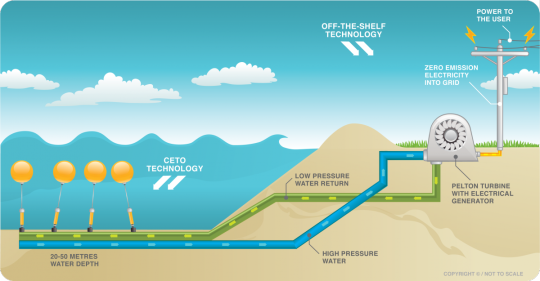
#wave energy converter market#waves#wave energy generation#wave energy production#wave energy#renewable electricity#renewable energy#renewables#green energy#renewablephilosopher#new technology#technology advancements#technology adoption#energy#energy production
6 notes
·
View notes
Text

#renewable electricity#renewable energy#windmill#wind park#wind power#gif#electricity#energy#power generator
48 notes
·
View notes